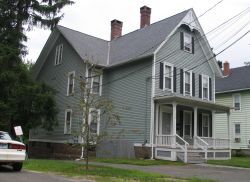
It has been 13 days since University housing officially opened for all undergraduates, and returning students are starting to feel settled. For the first time since May 2023, the class of 2025—second-largest in University history—has returned to campus in full force. With over 900 students, the class of 2025 gave rise to the infamous Bennet triples, squeezed class enrollment numbers to their breaking points, and has caused ongoing headaches for the Office of Residential Life (ResLife). Now, as they begin their final year at the University, members of the class of 2025 have moved into wood-frame houses. While some are celebrating their outdoor porches and spacious kitchens, others are lamenting about the fact that they will never receive the traditional housing typically promised to seniors.
“I feel very lucky to have gotten the house I did,” Lena Ostroy Harp ’25, a new resident of a Pine Street senior house, said.“Because if my group had a late time slot, we would have been really unhappy.”
Ostroy Harp and her housemates were lucky; they got their second pick of 3-person units and have been spending their mornings drinking coffee in the sunroom.
“There are some three-person groups who didn’t get housing until the summer,” Ostroy Harp said. “And that sucks for senior year.”
Other members of the senior class aren’t feeling so fortunate. The Fauver Apartments, a complex of five-person units on Foss Hill Drive that are typically considered junior housing, have been filled almost entirely with seniors for the 2024–2025 academic year.
“I think it is very indicative [of] the administration’s organization,” Ava Petillo ’25, whose housing group was placed near the bottom of the list of more than 50 five-person groups vying for wood-frame houses, said.“Because they knew for four years that they overenrolled [the class of 2025], and yet they chose to do nothing about the [limited housing].”
Petillo and her housemates are now living in a Fauver Apartment.
“They put people into forced triples in Bennet,” Petillo said. “And then they continued by messing up the housing for every other grade below us. And now, when they promised independent living in senior houses for our final year, they have failed to fulfill that promise.”
ResLife leadership, on the other hand, emphasized their efforts to identify enough beds in senior appropriate housing to accommodate every student in the class of 2025.
“In the recent past, smaller class sizes have led to the perception that all seniors, and some juniors, could be in wood frames and consequently that mostly juniors would be in Fauver, etc.,” ResLife Director Liliana Carrasquillo-Vasquez wrote in an email to The Argus. “This was not the case this year. However, there were enough senior appropriate beds for the larger class of 2025 to be housed between Fauver, wood frames, and [the Vine Street Apartments].”
In fact, many of the students affected by the housing crunch aren’t seniors at all.
“As with every year, the class size of the senior class and how they navigate their own decision-making process during housing selection impacts housing for all class years,” Carrasquillo-Vasquez wrote. “For this year, the impact was felt heavily on the classes of 2026 and 2027 the most, as what they had seen as possible for juniors and seniors was not the same housing selection context they were experiencing.”
Despite many members of the class of 2026 studying abroad this semester, housing options were few and far between for those who stayed behind.
“We had a group of four from the start, and we were planning to go in a Low Rise,” Sam Weitzman-Kurker ’26 said. “[We] didn’t end up getting that. And then options became very slim. We looked at off-campus housing, but that wasn’t going to work; there were some apartments down on Pearl Street, but [there were] safety issues there, so we ended up in [Science House]. I’m currently living in a double there. I’m with my friends, but living in a double in sophomore housing during my junior year is not particularly what I expected.”
Boarders in program housing like Weitzman-Kurker and his housing group bring with them a whole host of other implications. University program housing is designed to bring students together based on shared interests, hobbies, and identities, but the advent of boarders—often with no connection whatsoever to the mission of their assigned house—undermines that objective to the detriment of everyone involved.
“Everyone else applied to be there; they had to explain their science background and everything,” Weitzman-Kurker said. “We’re just coming in; none of us really have much of a science background. We’re obviously being respectful, but we’re kind of treating it like our Low Rise; we’re all hanging out in the same room.”
Despite it all, students are still finding ways to be excited about their housing in the new school year. Between trips to Waste Not, Goodwill, and Estate Treasures, posters are being command-stripped onto walls, dining tables are being negotiated into the perfect spots, and housing group family portraits are going up all over Instagram. Seniors in the class of 2025—living everywhere from the High Rise to Pine Palace—are largely just happy to be all back together again in one place.
Sam Weitzman-Kurker is an Argus Sports Editor.
Sophie Jager can be reached at sjager@wesleyan.edu.

